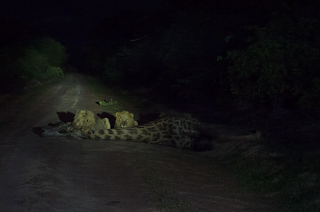 |
| Not my picture but exactly what it looked like. |
I had a friend visiting the states and he wanted to do something different than the traditional Zanzibar beach trip. I suggested Mafia Island, a relatively small island south of Zanzibar and Dar es Salaam. I know several people that have visited and expats especially gush that it is a laid back island paradise free of the crowds of Zanzibar. In addition, as luck would have it, the seasonal migration of whale sharks occurs during this time off the coast of the island.
Cursory research indicated there were basically two parts of the island to stay at, the first of which is Kilondoni. The largest town on the island (15,000 people), Kilondoni is the main port and town. There are a cluster of guesthouses ranging in price and quality that are adjacent to the town with a small stretch of undeveloped beach leading to mangroves. The second place for tourists to stay is a half hour to the east and is a much smaller settlement called Utende. Utende is located in a marine reserve though so visitors have to pay a $22.50/day conservation fee. I expected the area to be less settled but there are villages right up next to Utende shoreline and we saw fishing nets all along the bay and shore during our excursions. Utende has a few lodges on the beach but it is quite small with a constant ferry to the nearby Chole Island.
We initially decided to stay in Kilondoni with the impression that there'd be more stuff going on around the village (more dining options) and it was where the whale sharks were located. We chose Juani Beach Bungalows which was a pretty bad experience (poor value, location and facilities) though we were happy to stay close to the whale sharks the first day.
The whale sharks were pretty cool, certainly very accessible. They are very close to the shore so it didn't require a long boat ride and local fisherman gave the heads up that they had seen them. There were two other boats from other camps that were out but it wasn't over crowded. We initially saw only one whale shark but later saw a group of five. The boat gets as close as it can to the whale sharks and then scream for you to jump in. If you time it right and swim like an absolute maniac, one can stay next to the whale shark for maybe 30 seconds to one minute. It is really neat to see them so close and docile but they are surprisingly swift and leave you in the dust before you realize it.
We eventually moved to Meremeta Lodge in Utende and had a wonderful stay (NOTE: years later they cheated us on marine park fees saying they paid but they pocketed it, do not recommend!). We were the only ones staying there so it was quite comfortable and there are free bicycles available to bike 1km to the beach or in the surrounding villages. Unfortunately it rained for the three days that we were there but still had an amazing snorkeling trip one day, and a less than successful trip to a lagoon on a nearby island.
Overall I wasn't super enthralled with Mafia as some kind of untouched island paradise. I'm sure there are some more expensive very exclusive places to stay but I've visited some places in Zanzibar that I felt were similar and much easier logistically. The snorkeling and reefs were excellent and better than Zanzibar so perhaps divers are more attracted to Mafia. Perhaps if the weather was nicer I'd have a more positive experience since the beaches on the main island are really tiny and I think the day trips to the smaller islands are where it's at. Either way, I didn't have a bad time and certainly one of those holidays where I'm happy that I am content reading a nice book!



























